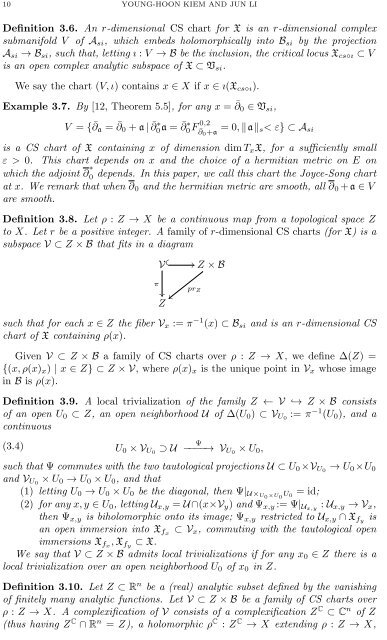Categorification of Donaldson-Thomas invariants via perverse ...
Categorification of Donaldson-Thomas invariants via perverse ...
Categorification of Donaldson-Thomas invariants via perverse ...
You also want an ePaper? Increase the reach of your titles
YUMPU automatically turns print PDFs into web optimized ePapers that Google loves.
10 YOUNG-HOON KIEM AND JUN LIDefinition 3.6. An r-dimensional CS chart for X is an r-dimensional complexsubmanifold V <strong>of</strong> A si , which embeds holomorphically into B si by the projectionA si → B si , such that, letting ı : V → B be the inclusion, the critical locus X cs◦ı ⊂ Vis an open complex analytic subspace <strong>of</strong> X ⊂ V si .We say the chart (V, ι) contains x ∈ X if x ∈ ı(X cs◦ı ).Example 3.7. By [12, Theorem 5.5], for any x = ¯∂ 0 ∈ V si ,V = { ¯∂ a = ¯∂ 0 + a | ¯∂ ∗ 0a = ¯∂ ∗ 0F 0,2¯∂ 0+a = 0, ‖a‖ s< ε} ⊂ A siis a CS chart <strong>of</strong> X containing x <strong>of</strong> dimension dim T x X, for a sufficiently smallε > 0. This chart depends on x and the choice <strong>of</strong> a hermitian metric on E onwhich the adjoint ∂ ∗ 0 depends. In this paper, we call this chart the Joyce-Song chartat x. We remark that when ∂ 0 and the hermitian metric are smooth, all ∂ 0 + a ∈ Vare smooth.Definition 3.8. Let ρ : Z → X be a continuous map from a topological space Zto X. Let r be a positive integer. A family <strong>of</strong> r-dimensional CS charts (for X) is asubspace V ⊂ Z × B that fits in a diagramV Z × BπZpr Zsuch that for each x ∈ Z the fiber V x := π −1 (x) ⊂ B si and is an r-dimensional CSchart <strong>of</strong> X containing ρ(x).Given V ⊂ Z × B a family <strong>of</strong> CS charts over ρ : Z → X, we define ∆(Z) ={(x, ρ(x) x ) | x ∈ Z} ⊂ Z × V, where ρ(x) x is the unique point in V x whose imagein B is ρ(x).Definition 3.9. A local tri<strong>via</strong>lization <strong>of</strong> the family Z ← V ↩→ Z × B consists<strong>of</strong> an open U 0 ⊂ Z, an open neighborhood U <strong>of</strong> ∆(U 0 ) ⊂ V U0 := π −1 (U 0 ), and acontinuous(3.4) U 0 × V U0 ⊃ UΨ−−−−→ V U0 × U 0 ,such that Ψ commutes with the two tautological projections U ⊂ U 0 ×V U0 → U 0 ×U 0and V U0 × U 0 → U 0 × U 0 , and that(1) letting U 0 → U 0 × U 0 be the diagonal, then Ψ| U×U0 ×U 0 U 0= id;(2) for any x, y ∈ U 0 , letting U x,y = U ∩(x×V y ) and Ψ x,y := Ψ| Ux,y : U x,y → V x ,then Ψ x,y is biholomorphic onto its image; Ψ x,y restricted to U x,y ∩ X fy isan open immersion into X fx ⊂ V x , commuting with the tautological openimmersions X fx , X fy ⊂ X.We say that V ⊂ Z × B admits local tri<strong>via</strong>lizations if for any x 0 ∈ Z there is alocal tri<strong>via</strong>lization over an open neighborhood U 0 <strong>of</strong> x 0 in Z.Definition 3.10. Let Z ⊂ R n be a (real) analytic subset defined by the vanishing<strong>of</strong> finitely many analytic functions. Let V ⊂ Z × B be a family <strong>of</strong> CS charts overρ : Z → X. A complexification <strong>of</strong> V consists <strong>of</strong> a complexification Z C ⊂ C n <strong>of</strong> Z(thus having Z C ∩ R n = Z), a holomorphic ρ C : Z C → X extending ρ : Z → X,













